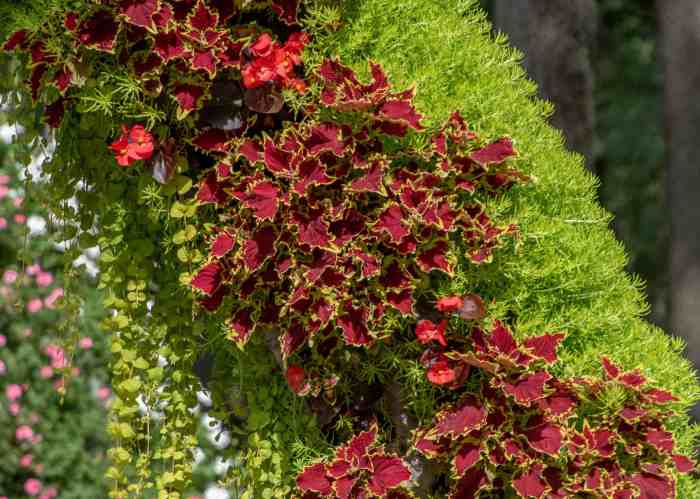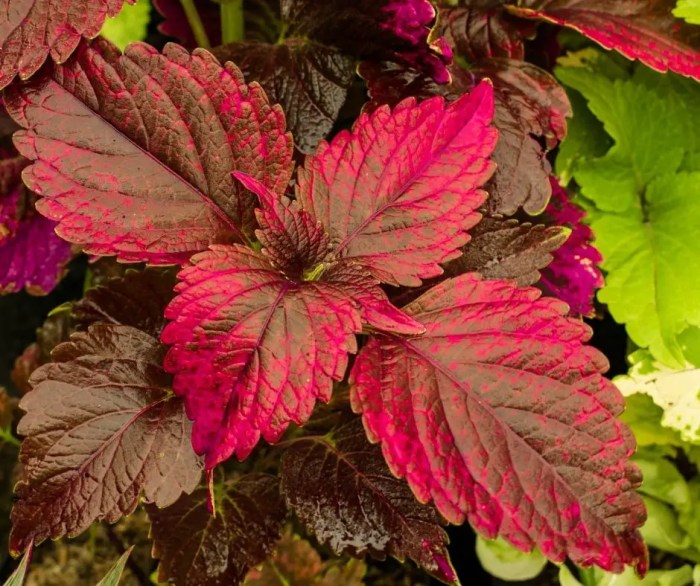How to trim coleus plants – Discover the art of trimming coleus plants and unlock their full potential for vibrant foliage and stunning growth habits. From understanding their growth patterns to mastering advanced shaping techniques, this comprehensive guide empowers you to transform your coleus into captivating garden masterpieces.
Understanding Coleus Plant Growth Patterns
Coleus plants exhibit diverse growth habits, influencing their suitability for various garden designs. Upright varieties, with their erect stems, create a vertical accent in borders and containers. Trailing coleus, featuring cascading stems, add a graceful touch to hanging baskets and window boxes.
Bushy coleus, characterized by compact growth, form dense mounds, ideal for groundcovers and edging.
Environmental Requirements
Optimal growth conditions are crucial for coleus to thrive. They prefer bright, indirect sunlight for vibrant foliage coloration. Temperatures between 60-80°F (15-27°C) promote healthy growth, while exposure to frost can damage plants. Well-drained, fertile soil rich in organic matter provides the necessary nutrients and moisture retention.
To keep coleus plants healthy and full, regular trimming is essential. Pinch off the growing tips of stems to encourage bushier growth. Similarly, cordyline plants also benefit from trimming to maintain their shape and prevent legginess. For detailed instructions on trimming cordyline plants, refer to how to trim cordyline plants . Returning to coleus plants, remove any dead or yellowing leaves to promote healthy growth and prevent disease.
Benefits of Trimming Coleus Plants
Regularly trimming coleus plants offers several advantages that contribute to their overall health and aesthetic appeal.
To trim coleus plants, use sharp shears to remove spent blooms and leggy stems. This encourages bushier growth and prevents the plant from becoming leggy. For a similar rejuvenation process on your rubber plants, check out our comprehensive guide on how to trim rubber plants . Returning to coleus plants, regular trimming also promotes vibrant foliage and keeps the plant looking its best.
Trimming coleus plants encourages bushier growth, resulting in a fuller and more compact appearance. By removing the tips of the stems, you stimulate the growth of lateral branches, creating a denser and more visually pleasing plant.
Enhancing Foliage Color
Trimming also enhances the vibrant foliage color of coleus plants. When you remove faded or damaged leaves and stems, you allow more sunlight to reach the healthy leaves, promoting photosynthesis and chlorophyll production. This results in brighter, more intense leaf colors and a more vibrant overall appearance.
Controlling Plant Size
Regular trimming is an effective way to control the size of coleus plants, preventing them from becoming overgrown or leggy. By selectively removing stems and branches, you can maintain a desired shape and height, making coleus plants suitable for various garden designs and containers.
Step-by-Step Trimming Guide: How To Trim Coleus Plants

Proper trimming is crucial for maintaining the health and beauty of coleus plants. Follow this step-by-step guide for effective trimming:
Selecting the Right Tools
Sharp, clean pruning shears are essential for precise cuts that minimize plant damage. Use bypass shears that make clean, angled cuts, rather than anvil shears that crush stems.
Identifying the Ideal Time for Trimming
Trim coleus plants regularly throughout the growing season, typically in spring and summer. Avoid trimming during cold or wet weather, as plants are more susceptible to disease and damage.
Pruning Techniques for Different Growth Habits
- Upright Growth:Cut back long, leggy stems to encourage bushier growth. Remove any dead or damaged leaves or stems.
- Trailing Growth:Trim back trailing stems to control their length and promote new growth. Remove any overgrown or damaged leaves.
- Compact Growth:Lightly trim the tips of stems to encourage branching and maintain a compact shape. Remove any yellowed or faded leaves.
Advanced Trimming Techniques

Beyond basic trimming, advanced techniques allow for more intricate shaping and styling of coleus plants. These techniques include creating topiaries, training coleus to climb trellises, and espaliering coleus plants for decorative effects.
Creating Topiaries
Topiaries are ornamental plants that are trimmed into specific shapes, such as animals, geometric figures, or even human forms. To create a topiary from a coleus plant, start with a young plant and trim it regularly to encourage dense growth.
Use sharp shears to carefully shape the plant, removing any excess foliage that detracts from the desired form.
Training Coleus to Climb Trellises
Coleus plants can be trained to climb trellises, adding height and visual interest to your garden. To do this, provide a trellis or other support structure and gently guide the stems of the coleus plant up the trellis as they grow.
Use twine or plant ties to secure the stems to the trellis, and trim any excess growth that does not contribute to the desired climbing effect.
Trimming coleus plants involves removing excess stems and leaves to promote healthy growth. For more general tips on trimming plants, refer to our guide on how to trim the plants . This comprehensive guide provides detailed instructions on trimming techniques, including pinching, deadheading, and shaping.
By following these tips, you can maintain the aesthetic appeal and overall health of your coleus plants.
Espaliering Coleus Plants
Espaliering is a technique used to train plants to grow flat against a wall or other surface. This can be done with coleus plants to create a decorative living wall or to add a unique touch to a patio or balcony.
To espalier a coleus plant, plant it close to a wall or other support structure and train the stems to grow horizontally along the surface. Use wire or hooks to secure the stems in place, and trim any excess growth that does not conform to the desired espaliered shape.
Troubleshooting Trimming Issues

Trimming coleus plants is generally a straightforward process, but certain issues can arise that may affect the plant’s health and appearance. Here are some common problems and solutions to consider:
Over-Pruning, How to trim coleus plants
Over-pruning can weaken the plant and make it more susceptible to pests and diseases. Avoid removing more than one-third of the plant’s stems at a time. If you have accidentally over-pruned, water the plant deeply and fertilize it to encourage new growth.
Trimming at the Wrong Time
Coleus plants should be trimmed during the growing season, typically from spring to fall. Avoid trimming in the winter when the plant is dormant, as this can damage it.
Diseases or Pests Affecting Trimmed Plants
Trimmed plants may be more vulnerable to diseases and pests. Inspect the plant regularly for signs of infestation or infection. If you notice any issues, treat the plant promptly with appropriate pesticides or fungicides.
Ultimate Conclusion

With the knowledge gained from this guide, you can confidently maintain and style your coleus plants, ensuring they thrive and bring joy to your garden for seasons to come. Embrace the art of trimming and unleash the boundless beauty of these versatile plants.
Question Bank
How often should I trim coleus plants?
Regular trimming every 4-6 weeks encourages bushier growth and prevents legginess.
What is the best time to trim coleus plants?
Trim during the growing season, typically spring through fall, when plants are actively growing.
How do I prevent over-pruning my coleus?
Avoid removing more than one-third of the plant’s growth at a time to maintain its health.